
Greco-Buddhist art
Encyclopedia
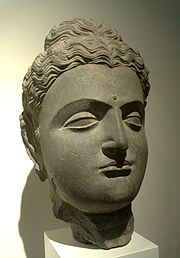
Greco-Buddhism
Greco-Buddhism, sometimes spelled Graeco-Buddhism, refers to the cultural syncretism between Hellenistic culture and Buddhism, which developed between the 4th century BCE and the 5th century CE in the area covered by the Indian sub-continent, and modern Afghanistan, Pakistan and north-western...
, a cultural syncretism
Syncretism
Syncretism is the combining of different beliefs, often while melding practices of various schools of thought. The term means "combining", but see below for the origin of the word...
between the Classical Greek
Ancient Greece
Ancient Greece is a civilization belonging to a period of Greek history that lasted from the Archaic period of the 8th to 6th centuries BC to the end of antiquity. Immediately following this period was the beginning of the Early Middle Ages and the Byzantine era. Included in Ancient Greece is the...
culture and Buddhism
Buddhism
Buddhism is a religion and philosophy encompassing a variety of traditions, beliefs and practices, largely based on teachings attributed to Siddhartha Gautama, commonly known as the Buddha . The Buddha lived and taught in the northeastern Indian subcontinent some time between the 6th and 4th...
, which developed over a period of close to 1000 years in Central Asia
Central Asia
Central Asia is a core region of the Asian continent from the Caspian Sea in the west, China in the east, Afghanistan in the south, and Russia in the north...
, between the conquests of Alexander the Great in the 4th century BCE, and the Islam
Islam
Islam . The most common are and . : Arabic pronunciation varies regionally. The first vowel ranges from ~~. The second vowel ranges from ~~~...
ic conquests of the 7th century CE. Greco-Buddhist art is characterized by the strong idealistic realism and sensuous description and of Hellenistic art and the first representations of the Buddha in human form, which have helped define the artistic (and particularly, sculptural) canon for Buddhist art throughout the Asian continent up to the present. It is also a strong example of cultural syncretism
Syncretism
Syncretism is the combining of different beliefs, often while melding practices of various schools of thought. The term means "combining", but see below for the origin of the word...
between eastern and western traditions.
The origins of Greco-Buddhist art are to be found in the Hellenistic Greco-Bactrian kingdom
Greco-Bactrian Kingdom
The Greco-Bactrian Kingdom was the easternmost part of the Hellenistic world, covering Bactria and Sogdiana in Central Asia from 250 to 125 BC...
(250 BCE- 130 BCE), located in today’s Afghanistan
Afghanistan
Afghanistan , officially the Islamic Republic of Afghanistan, is a landlocked country located in the centre of Asia, forming South Asia, Central Asia and the Middle East. With a population of about 29 million, it has an area of , making it the 42nd most populous and 41st largest nation in the world...
, from which Hellenistic culture radiated into the Indian subcontinent
Indian subcontinent
The Indian subcontinent, also Indian Subcontinent, Indo-Pak Subcontinent or South Asian Subcontinent is a region of the Asian continent on the Indian tectonic plate from the Hindu Kush or Hindu Koh, Himalayas and including the Kuen Lun and Karakoram ranges, forming a land mass which extends...
with the establishment of the Indo-Greek kingdom
Indo-Greek Kingdom
The Indo-Greek Kingdom or Graeco-Indian Kingdom covered various parts of the northwest regions of the Indian subcontinent during the last two centuries BC, and was ruled by more than 30 Hellenistic kings, often in conflict with each other...
(180 BCE-10 BCE). Under the Indo-Greeks and then the Kushans, the interaction of Greek and Buddhist culture flourished in the area of Gandhara
Gandhara
Gandhāra , is the name of an ancient kingdom , located in northern Pakistan and eastern Afghanistan. Gandhara was located mainly in the vale of Peshawar, the Potohar plateau and on the Kabul River...
, in today’s northern Pakistan
Pakistan
Pakistan , officially the Islamic Republic of Pakistan is a sovereign state in South Asia. It has a coastline along the Arabian Sea and the Gulf of Oman in the south and is bordered by Afghanistan and Iran in the west, India in the east and China in the far northeast. In the north, Tajikistan...
, before spreading further into India
India
India , officially the Republic of India , is a country in South Asia. It is the seventh-largest country by geographical area, the second-most populous country with over 1.2 billion people, and the most populous democracy in the world...
, influencing the art of Mathura, and then the Hindu
Hinduism
Hinduism is the predominant and indigenous religious tradition of the Indian Subcontinent. Hinduism is known to its followers as , amongst many other expressions...
art of the Gupta empire
Gupta Empire
The Gupta Empire was an ancient Indian empire which existed approximately from 320 to 550 CE and covered much of the Indian Subcontinent. Founded by Maharaja Sri-Gupta, the dynasty was the model of a classical civilization. The peace and prosperity created under leadership of Guptas enabled the...
, which was to extend to the rest of South-East Asia. The influence of Greco-Buddhist art also spread northward towards Central Asia
Central Asia
Central Asia is a core region of the Asian continent from the Caspian Sea in the west, China in the east, Afghanistan in the south, and Russia in the north...
, strongly affecting the art of the Tarim Basin
Tarim Basin
The Tarim Basin is a large endorheic basin occupying an area of about . It is located in the Xinjiang Uyghur Autonomous Region in China's far west. Its northern boundary is the Tian Shan mountain range and its southern is the Kunlun Mountains on the northern edge of the Tibetan Plateau. The...
, and ultimately the arts of China
China
Chinese civilization may refer to:* China for more general discussion of the country.* Chinese culture* Greater China, the transnational community of ethnic Chinese.* History of China* Sinosphere, the area historically affected by Chinese culture...
, Korea
Korea
Korea ) is an East Asian geographic region that is currently divided into two separate sovereign states — North Korea and South Korea. Located on the Korean Peninsula, Korea is bordered by the People's Republic of China to the northwest, Russia to the northeast, and is separated from Japan to the...
, and Japan
Japan
Japan is an island nation in East Asia. Located in the Pacific Ocean, it lies to the east of the Sea of Japan, China, North Korea, South Korea and Russia, stretching from the Sea of Okhotsk in the north to the East China Sea and Taiwan in the south...
.
Hellenistic art in southern Asia

Bactria
Bactria and also appears in the Zend Avesta as Bukhdi. It is the ancient name of a historical region located between south of the Amu Darya and west of the Indus River...
and Sogdiana
Sogdiana
Sogdiana or Sogdia was the ancient civilization of an Iranian people and a province of the Achaemenid Empire, eighteenth in the list on the Behistun Inscription of Darius the Great . Sogdiana is "listed" as the second of the "good lands and countries" that Ahura Mazda created...
, and later northern India for three centuries following the conquests of Alexander the Great around 330 BCE: the Seleucid empire until 250 BCE, followed by the Greco-Bactrian kingdom
Greco-Bactrian Kingdom
The Greco-Bactrian Kingdom was the easternmost part of the Hellenistic world, covering Bactria and Sogdiana in Central Asia from 250 to 125 BC...
until 130 BCE, and the Indo-Greek kingdom
Indo-Greek Kingdom
The Indo-Greek Kingdom or Graeco-Indian Kingdom covered various parts of the northwest regions of the Indian subcontinent during the last two centuries BC, and was ruled by more than 30 Hellenistic kings, often in conflict with each other...
from 180 BCE to around 10 BCE.
The clearest examples of Hellenistic art are found in the coins of the Greco-Bactrian kings of the period, such as Demetrius I of Bactria
Demetrius I of Bactria
Demetrius I was a Buddhist Greco-Bactrian king . He was the son of Euthydemus and succeeded him around 200 BC, after which he conquered extensive areas in what now is eastern Iran, Afghanistan and Pakistan thus creating an Indo-Greek kingdom far from Hellenistic Greece...
. Many coins of the Greco-Bactrian kings have been unearthed, including the largest silver and gold coins ever minted in the Hellenistic world, ranking among the best in artistic and technical sophistication: they "show a degree of individuality never matched by the often more bland descriptions of their royal contemporaries further West". ("Greece and the Hellenistic world").
These Hellenistic kingdoms established cities on the Greek model, such as in Ai-Khanoum
Ai-Khanoum
Ai-Khanoum or Ay Khanum , was founded in the 4th century BC, following the conquests of Alexander the Great and was one of the primary cities of the Greco-Bactrian kingdom...
in Bactria
Bactria
Bactria and also appears in the Zend Avesta as Bukhdi. It is the ancient name of a historical region located between south of the Amu Darya and west of the Indus River...
, displaying purely Hellenistic architectural features, Hellenistic statuary, and remains of Aristotelician
Aristotle
Aristotle was a Greek philosopher and polymath, a student of Plato and teacher of Alexander the Great. His writings cover many subjects, including physics, metaphysics, poetry, theater, music, logic, rhetoric, linguistics, politics, government, ethics, biology, and zoology...
papyrus prints and coin hoards.

Indo-Greek Kingdom
The Indo-Greek Kingdom or Graeco-Indian Kingdom covered various parts of the northwest regions of the Indian subcontinent during the last two centuries BC, and was ruled by more than 30 Hellenistic kings, often in conflict with each other...
in India. Fortified Greek cities, such as Sirkap
Sirkap
Sirkap is the name of an archaeological site on the bank opposite to the city of Taxila, Punjab, Pakistan.The city of Sirkap was built by the Greco-Bactrian king Demetrius after he invaded ancient India around 180 BC. Demetrius founded in the northern and northwestern Indian subcontinent an...
in northern Pakistan, were established. Architectural styles used Hellenistic decorative motifs such as fruit garland and scrolls. Stone palettes for aromatic oils representing purely Hellenistic themes such as a Nereid riding a Ketos sea monster are found.
In Hadda
Hadda
Hadda is a Greco-Buddhist archeological site located in the ancient area of Gandhara, near the Khyber Pass, ten kilometers south of the city of Jalalabad in today's eastern Afghanistan.-Background:...
, Hellenistic deities, such as Atlas
Atlas (mythology)
In Greek mythology, Atlas was the primordial Titan who supported the heavens. Although associated with various places, he became commonly identified with the Atlas Mountains in north-west Africa...
are found. Wind gods are depicted, which will affect the representation of wind deities as far as Japan. Dionysiac scenes represent people in Classical style drinking wine from amphoras and playing instruments.
Interaction
As soon as the Greeks invaded India to form the Indo-Greek kingdomIndo-Greek Kingdom
The Indo-Greek Kingdom or Graeco-Indian Kingdom covered various parts of the northwest regions of the Indian subcontinent during the last two centuries BC, and was ruled by more than 30 Hellenistic kings, often in conflict with each other...
, a fusion of Hellenistic and Buddhist elements started to appear, encouraged by the benevolence of the Greek kings towards Buddhism. This artistic trend then developed for several centuries and seemed to flourish further during the Kushan Empire
Kushan Empire
The Kushan Empire originally formed in the early 1st century AD under Kujula Kadphises in the territories of ancient Bactria on either side of the middle course of the Oxus in what is now northern Afghanistan, Pakistan, and southern Tajikistan and Uzbekistan.During the 1st and early 2nd centuries...
from the 1st century CE.
Artistic model

The Bodhisattva
Bodhisattva
In Buddhism, a bodhisattva is either an enlightened existence or an enlightenment-being or, given the variant Sanskrit spelling satva rather than sattva, "heroic-minded one for enlightenment ." The Pali term has sometimes been translated as "wisdom-being," although in modern publications, and...
s are depicted as bare-chested and jewelled Indian princes, and the Buddhas
Buddhahood
In Buddhism, buddhahood is the state of perfect enlightenment attained by a buddha .In Buddhism, the term buddha usually refers to one who has become enlightened...
as Greek kings wearing the light toga
Toga
The toga, a distinctive garment of Ancient Rome, was a cloth of perhaps 20 ft in length which was wrapped around the body and was generally worn over a tunic. The toga was made of wool, and the tunic under it often was made of linen. After the 2nd century BC, the toga was a garment worn...
-like himation. The buildings in which they are depicted incorporate Greek style, with the ubiquitous Indo-Corinthian capital
Indo-Corinthian capital
Indo-Corinthian capitals are capitals crowning columns or pilasters, which can be found in the northwestern Indian subcontinent, and usually combine Hellenistic and Indian elements...
s and Greek decorative scrolls. Surrounding deities form a pantheon of Greek (Atlas
Atlas (mythology)
In Greek mythology, Atlas was the primordial Titan who supported the heavens. Although associated with various places, he became commonly identified with the Atlas Mountains in north-west Africa...
, Herakles) and Indian gods (Indra
Indra
' or is the King of the demi-gods or Devas and Lord of Heaven or Svargaloka in Hindu mythology. He is also the God of War, Storms, and Rainfall.Indra is one of the chief deities in the Rigveda...
).
Material
Stucco as well as stone was widely used by sculptors in Gandhara for the decoration of monastic and cult buildings. Stucco provided the artist with a medium of great plasticity, enabling a high degree of expresivness to be given to the sculpture. Sculpting in stucco was popular wherever Buddhism spread from Gandhara - India, Afghanistan, Central Asia and China.Stylistic evolution
Stylistically, Greco-Buddhist art started by being extremely fine and realistic, as apparent on the standing Buddhas, with "a realistic treatment of the folds and on some even a hint of modelled volume that characterizes the best Greek work" (Boardman). It then lost this sophisticated realism, becoming progressively more symbolic and decorative over the centuries.Architecture
The presence of stupaStupa
A stupa is a mound-like structure containing Buddhist relics, typically the remains of Buddha, used by Buddhists as a place of worship....
s at the Greek city of Sirkap
Sirkap
Sirkap is the name of an archaeological site on the bank opposite to the city of Taxila, Punjab, Pakistan.The city of Sirkap was built by the Greco-Bactrian king Demetrius after he invaded ancient India around 180 BC. Demetrius founded in the northern and northwestern Indian subcontinent an...
, which was built by Demetrius
Demetrius I of Bactria
Demetrius I was a Buddhist Greco-Bactrian king . He was the son of Euthydemus and succeeded him around 200 BC, after which he conquered extensive areas in what now is eastern Iran, Afghanistan and Pakistan thus creating an Indo-Greek kingdom far from Hellenistic Greece...
around 180 BCE, already indicates a strong syncretism between Hellenism and the Buddhist faith
Buddhism
Buddhism is a religion and philosophy encompassing a variety of traditions, beliefs and practices, largely based on teachings attributed to Siddhartha Gautama, commonly known as the Buddha . The Buddha lived and taught in the northeastern Indian subcontinent some time between the 6th and 4th...
, together with other religions such as Hinduism
Hinduism
Hinduism is the predominant and indigenous religious tradition of the Indian Subcontinent. Hinduism is known to its followers as , amongst many other expressions...
and Zoroastrianism
Zoroastrianism
Zoroastrianism is a religion and philosophy based on the teachings of prophet Zoroaster and was formerly among the world's largest religions. It was probably founded some time before the 6th century BCE in Greater Iran.In Zoroastrianism, the Creator Ahura Mazda is all good, and no evil...
. The style is Greek, adorned with Corinthian columns in excellent Hellenistic execution.
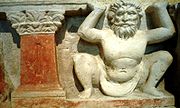
Atlas (mythology)
In Greek mythology, Atlas was the primordial Titan who supported the heavens. Although associated with various places, he became commonly identified with the Atlas Mountains in north-west Africa...
is represented holding Buddhist monuments with decorated Greek columns. The motif was adopted extensively throughout the Indian sub-continent, Atlas being substituted for the Indian Yaksa
Yaksa
Yaksa or Yaksha may refer to:* Yaksha , nature-spirit in Hindu, Jainishm, and Buddhism* Yaksha Kingdom, ancient kingdom in Indian epic literature* Yakkha, also called "Yaksa-sh"...
in the monuments of the Sunga around the 2nd century BCE.
Buddha
.jpg)
Many of the stylistic elements in the representations of the Buddha point to Greek influence: the Greek himation
Himation
A himation was a type of clothing in ancient Greece. It was usually worn over a chiton, but was made of heavier drape and played the role of a cloak.The himation was markedly less voluminous than the Roman toga....
(a light toga
Toga
The toga, a distinctive garment of Ancient Rome, was a cloth of perhaps 20 ft in length which was wrapped around the body and was generally worn over a tunic. The toga was made of wool, and the tunic under it often was made of linen. After the 2nd century BC, the toga was a garment worn...
-like wavy robe covering both shoulders: Buddhist characters are always represented with a dhoti
Dhoti
The dhoti or pancha is the traditional men's garment in the in India, Bangladesh and Sri Lanka. A similar garment is worn in some rural areas of Punjab province in Pakistan, but the use is fast declining...
loincloth
Loincloth
A loincloth is a one-piece male garment, sometimes kept in place by a belt, which covers the genitals and, at least partially, the buttocks.-History and types:Loincloths are being and have been worn:*in societies where no other clothing is needed or wanted...
before this innovation), the halo
Halo (religious iconography)
A halo is a ring of light that surrounds a person in art. They have been used in the iconography of many religions to indicate holy or sacred figures, and have at various periods also been used in images of rulers or heroes...
, the contrapposto
Contrapposto
Contrapposto is an Italian term that means counterpose. It is used in the visual arts to describe a human figure standing with most of its weight on one foot so that its shoulders and arms twist off-axis from the hips and legs. This gives the figure a more dynamic, or alternatively relaxed...
stance of the upright figures (see: 1st–2nd century Gandhara standing Buddhas and ), the stylized Mediterranean curly hair and top-knot apparently derived from the style of the Belvedere Apollo
Apollo Belvedere
The Apollo Belvedere or Apollo of the Belvedere—also called the Pythian Apollo— is a celebrated marble sculpture from Classical Antiquity. It was rediscovered in central Italy in the late 15th century, during the Renaissance...
(330 BCE), and the measured quality of the faces, all rendered with strong artistic realism
Realism (visual arts)
Realism in the visual arts is a style that depicts the actuality of what the eyes can see. The term is used in different senses in art history; it may mean the same as illusionism, the representation of subjects with visual mimesis or verisimilitude, or may mean an emphasis on the actuality of...
(See: Greek art
Greek art
Greek art began in the Cycladic and Minoan prehistorical civilization, and gave birth to Western classical art in the ancient period...
). Some of the standing Buddhas (as the one pictured) were sculpted using the specific Greek technique of making the hands and sometimes the feet in marble to increase the realistic effect, and the rest of the body in another material.
Foucher especially considered Hellenistic free-standing Buddhas as "the most beautiful, and probably the most ancient of the Buddhas", assigning them to the 1st century BCE, and making them the starting point of the anthropomorphic representations of the Buddha ("The Buddhist art of Gandhara", Marshall, p101).
Development

Indo-Scythians
Indo-Scythians is a term used to refer to Sakas , who migrated into Bactria, Sogdiana, Arachosia, Gandhara, Kashmir, Punjab, Haryana, Uttar Pradesh, Gujarat, Maharashtra and Rajasthan, from the middle of the 2nd century BCE to the 4th century CE....
, the Indo-Parthians or the Kushans under Hellenistic artistic influence. Most of the early images of the Buddha (especially those of the standing Buddha) are anepigraphic, which makes it difficult to have a definite dating. The earliest known image of the Buddha with approximate indications on date is the Bimaran casket
Bimaran casket
The Bimaran casket is a small gold reliquary for Buddhist relics that was found inside the stupa no.2 at Bimaran, near Jalalabad in eastern Afghanistan....
, which has been found buried with coins of the Indo-Scythian king Azes II
Azes II
Azes II , may have been the last Indo-Scythian king in northern Indian subcontinent . After the death of Azes II, the rule of the Indo-Scythians in northwestern India and Pakistan finally crumbled with the conquest of the Kushans, one of the five tribes of the Yuezhi who had lived in Bactria for...
(or possibly Azes I
Azes I
Azes I was an Indo-Scythian ruler who completed the domination of the Scythians in northern India.-History:Although Maues and his successors had conquered the areas of Gandhara, as well as the area of Mathura from 85 BCE, they were unsuccessful against the Indo-Greek kings remaining behind the...
), indicating a 30-10 BCE date, although this date is not undisputed.
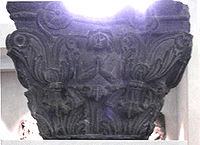
Himation
A himation was a type of clothing in ancient Greece. It was usually worn over a chiton, but was made of heavier drape and played the role of a cloak.The himation was markedly less voluminous than the Roman toga....
dress, contrapposto
Contrapposto
Contrapposto is an Italian term that means counterpose. It is used in the visual arts to describe a human figure standing with most of its weight on one foot so that its shoulders and arms twist off-axis from the hips and legs. This gives the figure a more dynamic, or alternatively relaxed...
attitude, general depiction) would made it a possible Indo-Greek work, used in dedications by Indo-Scythians soon after the end of Indo-Greek rule in the area of Gandhara
Gandhara
Gandhāra , is the name of an ancient kingdom , located in northern Pakistan and eastern Afghanistan. Gandhara was located mainly in the vale of Peshawar, the Potohar plateau and on the Kabul River...
. Since it already displays quite a sophisticated iconography (Brahma
Brahma (Buddhism)
' in Buddhism is the name for a type of exalted passionless deity , of which there are several in Buddhist cosmology.-Origins:The name originates in Vedic tradition, in which Brahmā appears as the creator of the universe...
and Śakra
Sakra
Śakra or Sakka is the ruler of the Heaven according to Buddhist cosmology. His full title is |deva]]s". In Buddhist texts, Śakra is the proper name and not an epithet of this deity; conversely, Indra in Sanskrit and Inda in Pali are sometimes used as an epithet for Śakra as "lord".In East...
as attendants, Bodhisattva
Bodhisattva
In Buddhism, a bodhisattva is either an enlightened existence or an enlightenment-being or, given the variant Sanskrit spelling satva rather than sattva, "heroic-minded one for enlightenment ." The Pali term has sometimes been translated as "wisdom-being," although in modern publications, and...
s) in an advanced style, it would suggest much earlier representations of the Buddha were already current by that time, going back to the rule of the Indo-Greeks (Alfred A. Foucher
Alfred A. Foucher
Alfred Foucher , a French scholar, identified the Buddha image as having Greek origins.He made his first trip to northeastern India in 1895...
and others).
The next Greco-Buddhist findings to be strictly datable are rather late, such as the c.120 CE Kanishka casket
Kanishka casket
The Kanishka casket or "Kanishka reliquary", is a Buddhist reliquary made in gilted copper, and dated to the first year of the reign of the Kushan emperor Kanishka, in 127 CE.-History and description:...
and Kanishka
Kanishka
Kanishka ) was an emperor of the Kushan Empire, ruling an empire extending from Bactria to large parts of northern India in the 2nd century of the common era, and famous for his military, political, and spiritual achievements...
's Buddhist coins. These works at least indicate though that the anthropomorphic representation of the Buddha was already extant in the 1st century CE.

Tarim Basin
The Tarim Basin is a large endorheic basin occupying an area of about . It is located in the Xinjiang Uyghur Autonomous Region in China's far west. Its northern boundary is the Tian Shan mountain range and its southern is the Kunlun Mountains on the northern edge of the Tibetan Plateau. The...
city of Dunhuang
Dunhuang
Dunhuang is a city in northwestern Gansu province, Western China. It was a major stop on the ancient Silk Road. It was also known at times as Shāzhōu , or 'City of Sands', a name still used today...
accurately describe the travels of the explorer and ambassador Zhang Qian
Zhang Qian
Zhang Qian was an imperial envoy to the world outside of China in the 2nd century BCE, during the time of the Han Dynasty...
to Central Asia
Central Asia
Central Asia is a core region of the Asian continent from the Caspian Sea in the west, China in the east, Afghanistan in the south, and Russia in the north...
as far as Bactria
Bactria
Bactria and also appears in the Zend Avesta as Bukhdi. It is the ancient name of a historical region located between south of the Amu Darya and west of the Indus River...
around 130 BCE, and the same murals describe the Emperor Han Wudi (156-87 BCE) worshipping Buddhist statues, explaining them as "golden men brought in 120 BCE by a great Han general in his campaigns against the nomads." Although there is no other mention of Han Wudi worshipping the Buddha in Chinese historical literature, the murals would suggest that statues of the Buddha were already in existence during the 2nd century BCE, connecting them directly to the time of the Indo-Greeks.
Later, the Chinese historical chronicle Hou Hanshu describes the enquiry about Buddhism made around 67 CE by the emperor Emperor Ming (58-75 CE). He sent an envoy to the Yuezhi
Yuezhi
The Yuezhi, or Rouzhi , also known as the Da Yuezhi or Da Rouzhi , were an ancient Central Asian people....
in northwestern India, who brought back paintings and statues of the Buddha, confirming their existence before that date:
- "The Emperor, to discover the true doctrine, sent an envoy to TianzhuTianzhu-Locations in China:*Mount Tianzhu , in Anhui*Tianzhu County, Guizhou , in Qiandongnan Miao and Dong Autonomous Prefecture, Guizhou*Tenzhu Tibetan Autonomous County , or Tianzhu, of Wuwei, Gansu...
(Northwestern India) to inquire about the Buddha’s doctrine, after which paintings and statues [of the Buddha] appeared in the Middle Kingdom." (Hou Hanshu, trans. John Hill)
An Indo-Chinese tradition also explains that Nagasena
Nagasena
Nāgasena was a Brahmin who became a Buddhist sage lived about 150 BCE. His answers to questions about Buddhism posed by Menander I , the Indo-Greek king of northwestern India , are recorded in the Milinda Pañha....
, also known as Menander
Menander I
Menander I Soter "The Saviour" was one of the rulers of the Indo-Greek Kingdom from either 165 or 155 BC to 130 BC ....
's Buddhist teacher, created in 43 BCE in the city of Pataliputra a statue of the Buddha, the Emerald Buddha
Emerald Buddha
The Emerald Buddha is the palladium of the Kingdom of Thailand, a figurine of the sitting Buddha, made of green jadeite , clothed in gold, and about 45 cm tall...
, which was later brought to Thailand
Thailand
Thailand , officially the Kingdom of Thailand , formerly known as Siam , is a country located at the centre of the Indochina peninsula and Southeast Asia. It is bordered to the north by Burma and Laos, to the east by Laos and Cambodia, to the south by the Gulf of Thailand and Malaysia, and to the...
.
Artistic model
The Greco-Bactrian king Demetrius IDemetrius I of Bactria
Demetrius I was a Buddhist Greco-Bactrian king . He was the son of Euthydemus and succeeded him around 200 BC, after which he conquered extensive areas in what now is eastern Iran, Afghanistan and Pakistan thus creating an Indo-Greek kingdom far from Hellenistic Greece...
(205-171 BCE) himself may have been the prototype for the image of the Buddha. He was king and saviour of India, as confirmed by his successors King Apollodotus I and Menander I
Menander I
Menander I Soter "The Saviour" was one of the rulers of the Indo-Greek Kingdom from either 165 or 155 BC to 130 BC ....
, who were officially described as ΒΑΣΙΛΕΩΣ ΣΩTHPOΣ (basileōs sotēros) "saviour king" in the bilingual Greek
Greek language
Greek is an independent branch of the Indo-European family of languages. Native to the southern Balkans, it has the longest documented history of any Indo-European language, spanning 34 centuries of written records. Its writing system has been the Greek alphabet for the majority of its history;...
and Kharoshthi legends of their coins. Demetrius was named Dharmamita ("Friend of the Dharma
Dharma
Dharma means Law or Natural Law and is a concept of central importance in Indian philosophy and religion. In the context of Hinduism, it refers to one's personal obligations, calling and duties, and a Hindu's dharma is affected by the person's age, caste, class, occupation, and gender...
") in the Indian text of the Yuga Purana
Yuga Purana
The Yuga Purana is an ancient Indian text, part of the larger Puranic literature. It is considered as one of the oldest Purana, written around 250 CE. The Yuga Purana consists two chapters, within the larger text of the Gargi Samhita, also called Vriddha Gargiya Jyotisha...
. Buddhism flourished under his reign and that of his successors, precisely as it was being oppressed by the Indian dynasty of the Sunga in the East.

Dharmacakra
The Dharmachakra , lit. "Wheel of Dharma" or "Wheel of Life" is a symbol that has represented dharma, the Buddha's teaching of the path to enlightenment, since the early period of Indian Buddhism. A similar symbol is also in use in Jainism...
, the empty throne, the Bodhi tree
Bodhi tree
The Bodhi Tree, also known as Bo , was a large and very old Sacred Fig tree located in Bodh Gaya , under which Siddhartha Gautama, the spiritual teacher and founder of Buddhism later known as Gautama Buddha, is said to have achieved enlightenment, or Bodhi...
, the lions) are absent. Demetrius may have been deified, and the first Hellenistic statues of the Buddha we know may be representations of the idealized Greek king, princely, yet friendly, protective and open to Indian culture. As they progressively incorporated more Buddhist elements, they became central to the Buddhist movement, and influenced the representations of the Buddha
Gautama Buddha
Siddhārtha Gautama was a spiritual teacher from the Indian subcontinent, on whose teachings Buddhism was founded. In most Buddhist traditions, he is regarded as the Supreme Buddha Siddhārtha Gautama (Sanskrit: सिद्धार्थ गौतम; Pali: Siddhattha Gotama) was a spiritual teacher from the Indian...
in Greco-Buddhist art and later.
Another characteristic of Demetrius is associated to the Buddha: they share the same protector deity. In Gandharan art, the Buddha is often shown under the protection of the Greek god Herakles, standing with his club (and later a diamond rod) resting over his arm. This unusual representation of Herakles is the same as the one on the back of Demetrius' coins, and it is exclusively associated to him (and his son Euthydemus II
Euthydemus II
Euthydemus II was a son of Demetrius I of Bactria, and became king of Bactria in the 180s BCE, either after his father's death or as a sub-king to him. The style and rare nickel alloys of his coins associates him closely in time with the king Agathocles but their precise relation remains uncertain...
), seen only on the back of his coins.
Soon, the figure of the Buddha was incorporated within architectural designs, such as Corinthian pillars and friezes. Scenes of the life of the Buddha are typically depicted in a Greek architectural environment, with protagonist wearing Greek clothes.
Gods and Bodhisattvas
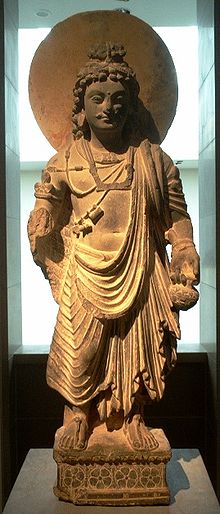
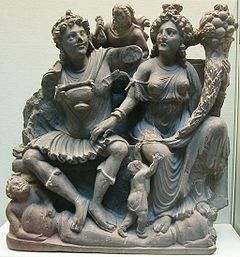
Vajrapani
' is one of the earliest bodhisattvas of Mahayana Buddhism. He is the protector and guide of the Buddha, and rose to symbolize the Buddha's power. Vajrapani was used extensively in Buddhist iconography as one of the three protective deities surrounding the Buddha...
, the protector of the Buddha. Other Greek deities abundantly used in Greco-Buddhist art are representation of Atlas
Atlas (mythology)
In Greek mythology, Atlas was the primordial Titan who supported the heavens. Although associated with various places, he became commonly identified with the Atlas Mountains in north-west Africa...
, and the Greek wind god Boreas. Atlas in particular tends to be involved as a sustaining elements in Buddhist architectural elements. Boreas became the Japanese wind god Fujin
Fujin
is the Japanese god of the wind and one of the eldest Shinto gods.He is portrayed as a terrifying dark demon, resembling a red headed black humanoid wearing a leopard skin, carrying a large bag of winds on his shoulders....
through the Greco-Buddhist Wardo. The mother deity Hariti
Hariti
Hārītī , is a Gandharan ogeress and Bactrian mythological figure who was later transformed in to a symbol for the protection of children, easy delivery, happy child rearing and parenting, harmony between husband and wife, love, and the well-being and safety of the family...
was inspired by Tyche
Tyche
In ancient Greek city cults, Tyche was the presiding tutelary deity that governed the fortune and prosperity of a city, its destiny....
.
Particularly under the Kushans, there are also numerous representations of richly adorned, princely Bodhisattva
Bodhisattva
In Buddhism, a bodhisattva is either an enlightened existence or an enlightenment-being or, given the variant Sanskrit spelling satva rather than sattva, "heroic-minded one for enlightenment ." The Pali term has sometimes been translated as "wisdom-being," although in modern publications, and...
s all in a very realistic Greco-Buddhist style. The Bodhisattvas, characteristic of the Mahayana
Mahayana
Mahāyāna is one of the two main existing branches of Buddhism and a term for classification of Buddhist philosophies and practice...
form of Buddhism, are represented under the traits of Kushan princes, completed with their canonical accessories.
Cupids
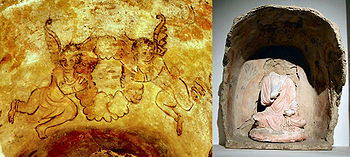
Wreath
A wreath is an assortment of flowers, leaves, fruits, twigs and/or various materials that is constructed to resemble a ring. They are used typically as Christmas decorations to symbolize the coming of Christ, also known as the Advent season in Christianity. They are also used as festive headdresses...
, the Greek symbol of victory and kingship, over the Buddha.
These figures, also known as "apsarases" were extensively adopted in Buddhist art, especially throughout Eastern Asia, in forms derivative to the Greco-Buddhist representation. The progressive evolution of the style can be seen in the art of Qizil and Dunhuang
Dunhuang
Dunhuang is a city in northwestern Gansu province, Western China. It was a major stop on the ancient Silk Road. It was also known at times as Shāzhōu , or 'City of Sands', a name still used today...
. It is unclear however if the concept of the flying cupids was brought to India from the West, of if it had an independent Indian origin, although Boardman considers it a Classical contribution: "Another Classical motif we found in India is the pair of hovering winged figures, generally called apsaras." (Boardman)
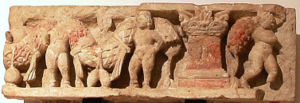
Garland (decoration)
A garland is a decorative wreath or cord, used at festive occasions, which can be hung round a person's neck, or on inanimate objects like Christmas trees. Originally garlands were made of flowers or leaves.-Etymology:...
s, sometimes adorned with fruits, is another very popular Gandharan motif, directly inspired from Greek art. It is sometimes argued that the only concession to Indian art appears in the anklets worn by the cupids. These scenes had a very broad influence, as far as Amaravati
Amaravati, Andhra Pradesh
Amaravathi is a small town situated on the banks of the River Krishna in the Guntur District of Andhra Pradesh, India. It is famous for its Amareswara temple dedicated to Lord Shiva. The temple is one of the famous Pancharamas. Amaravati, also known as Dhanyakataka/Dharanikota was the site of a...
on the eastern coast of India, where the cupids are replaced by yakṣa
Yaksa
Yaksa or Yaksha may refer to:* Yaksha , nature-spirit in Hindu, Jainishm, and Buddhism* Yaksha Kingdom, ancient kingdom in Indian epic literature* Yakkha, also called "Yaksa-sh"...
s.
Devotees
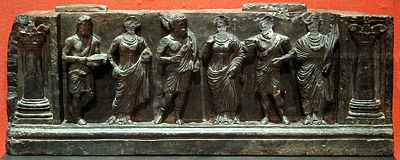
Some groups, often described as the "Buner reliefs
Buner reliefs
The Buner reliefs are a series of frieze reliefs that lie in Buner District, from the area of the Peshawar valley in Pakistan. They are also near the Swat Valley.-Hellenistic scenes:...
," usually dated to the 1st century CE, depict Greeks in perfect Hellenistic style, either in posture, rendering, or clothing (wearing the Greek chiton
Chiton (costume)
A chiton was a form of clothing worn by men and women in Ancient Greece, from the Archaic period to the Hellenistic period ....
and himation
Himation
A himation was a type of clothing in ancient Greece. It was usually worn over a chiton, but was made of heavier drape and played the role of a cloak.The himation was markedly less voluminous than the Roman toga....
). It is sometimes even difficult to perceive an actual religious message behind the scenes. (The devotee scene on the right might, with doubt, depict of the presentation of Prince Siddharta
Gautama Buddha
Siddhārtha Gautama was a spiritual teacher from the Indian subcontinent, on whose teachings Buddhism was founded. In most Buddhist traditions, he is regarded as the Supreme Buddha Siddhārtha Gautama (Sanskrit: सिद्धार्थ गौतम; Pali: Siddhattha Gotama) was a spiritual teacher from the Indian...
to his bride. It may also just be a festive scene.)
About a century later, friezes also depict Kushan devotees, usually with the Buddha as the central figure.
Fantastic animals
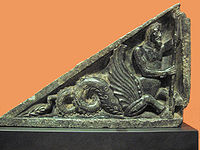
Sirkap
Sirkap is the name of an archaeological site on the bank opposite to the city of Taxila, Punjab, Pakistan.The city of Sirkap was built by the Greco-Bactrian king Demetrius after he invaded ancient India around 180 BC. Demetrius founded in the northern and northwestern Indian subcontinent an...
. Among the most popular fantastic animals are triton
Triton (mythology)
Triton is a mythological Greek god, the messenger of the big sea. He is the son of Poseidon, god of the sea, and Amphitrite, goddess of the sea, whose herald he is...
s, ichthyo-centaurs and ketos sea-monsters. It should be noted that similar fantastic animals are found in ancient Egyptian reliefs, and might therefore have been passed on to Bactria and India independently of Greek imperialism.
As fantastic animals of the sea, they were, in early Buddhism, supposed to safely bring the souls of dead people to Paradise beyond the waters. These motifs were later adopted in Indian art, where they influenced the depiction of the Indian monster makara, Varuna
Varuna
In Vedic religion, Varuna is a god of the sky, of water and of the celestial ocean, as well as a god of law and of the underworld...
's mount.
Kushan contribution
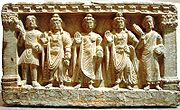
Kushan Empire
The Kushan Empire originally formed in the early 1st century AD under Kujula Kadphises in the territories of ancient Bactria on either side of the middle course of the Oxus in what is now northern Afghanistan, Pakistan, and southern Tajikistan and Uzbekistan.During the 1st and early 2nd centuries...
. The Kushans were nomadic people who started migrating from the Tarim Basin
Tarim Basin
The Tarim Basin is a large endorheic basin occupying an area of about . It is located in the Xinjiang Uyghur Autonomous Region in China's far west. Its northern boundary is the Tian Shan mountain range and its southern is the Kunlun Mountains on the northern edge of the Tibetan Plateau. The...
in Central Asia
Central Asia
Central Asia is a core region of the Asian continent from the Caspian Sea in the west, China in the east, Afghanistan in the south, and Russia in the north...
from around 170 BCE and ended up founding an empire in northwestern India from the 2nd century BCE, after having been rather Hellenized through their contacts with the Greco-Bactrians, and later the Indo-Greeks (they adopted the Greek script for writing).
The Kushans, at the center of the Silk Road
Silk Road
The Silk Road or Silk Route refers to a historical network of interlinking trade routes across the Afro-Eurasian landmass that connected East, South, and Western Asia with the Mediterranean and European world, as well as parts of North and East Africa...
enthusiastically gathered works of art from all the quarters of the ancient world, as suggested by the hoards found in their northern capital in the archeological site of Begram, Afghanistan
Afghanistan
Afghanistan , officially the Islamic Republic of Afghanistan, is a landlocked country located in the centre of Asia, forming South Asia, Central Asia and the Middle East. With a population of about 29 million, it has an area of , making it the 42nd most populous and 41st largest nation in the world...
.
The Kushans sponsored Buddhism together with other Iranian and Hindu faiths, and probably contributed to the flourishing of Greco-Buddhist art. Their coins, however, suggest a lack of artistic sophistication: the representations of their kings, such as Kanishka
Kanishka
Kanishka ) was an emperor of the Kushan Empire, ruling an empire extending from Bactria to large parts of northern India in the 2nd century of the common era, and famous for his military, political, and spiritual achievements...
, tend to be crude (lack of proportion, rough drawing), and the image of the Buddha is an assemblage of a Hellenistic Buddha statue with feet grossly represented and spread apart in the same fashion as the Kushan king. This tends to indicate the anteriority of the Hellenistic Greco-Buddhist statues, used as models, and a subsequent corruption by Kushan artists.
Art of the Sunga

.jpg)
Sunga Empire
The Sunga Empire or Shunga Empire was a royal Indian dynasty from Magadha that controlled vast areas of the Indian Subcontinent from around 185 to 73 BCE. The dynasty was established by Pusyamitra Sunga, after the fall of the Maurya Empire...
(183-73 BCE) are usually faint. The main religion, at least at the beginning, seems to have been Brahmanic Hinduism, although some late Buddhist realizations in Madhya Pradesh
Madhya Pradesh
Madhya Pradesh , often called the Heart of India, is a state in central India. Its capital is Bhopal and Indore is the largest city....
as also known, such as some architectural expansions that were done at the stupa
Stupa
A stupa is a mound-like structure containing Buddhist relics, typically the remains of Buddha, used by Buddhists as a place of worship....
s of Sanchi
Sanchi
Sanchi is a small village in Raisen District of the state of Madhya Pradesh, India, it is located 46 km north east of Bhopal, and 10 km from Besnagar and Vidisha in the central part of the state of Madhya Pradesh. It is the location of several Buddhist monuments dating from the 3rd...
and Bharhut
Bharhut
Bharhut or Barhut , is a location in Satna district in Madhya Pradesh, Central India, known for its famous Buddhist stupa. The Bharhut stupa may have been established by the Maurya king Asoka in the 3rd century BCE, but many works of art were apparently added during the Sunga period, with many...
, originally started under King Ashoka
Ashoka
Ashok Maurya or Ashoka , popularly known as Ashoka the Great, was an Indian emperor of the Maurya Dynasty who ruled almost all of the Indian subcontinent from ca. 269 BC to 232 BC. One of India's greatest emperors, Ashoka reigned over most of present-day India after a number of military conquests...
.
This Sunga-period balustrate-holding Atalante
Atalante
Atalante or similar terms can refer to:* Atalanta, a character of ancient Greek mythology* 36 Atalante, an asteroid* L'Atalante, a 1934 French film* L'Atalante basin, a deep hypersaline anoxic basin in the Mediterranean sea....
Yaksa
Yaksa
Yaksa or Yaksha may refer to:* Yaksha , nature-spirit in Hindu, Jainishm, and Buddhism* Yaksha Kingdom, ancient kingdom in Indian epic literature* Yakkha, also called "Yaksa-sh"...
from the Sunga period (left), adopts the Atalante
Atalante
Atalante or similar terms can refer to:* Atalanta, a character of ancient Greek mythology* 36 Atalante, an asteroid* L'Atalante, a 1934 French film* L'Atalante basin, a deep hypersaline anoxic basin in the Mediterranean sea....
theme, usually fulfilled by Atlas
Atlas (mythology)
In Greek mythology, Atlas was the primordial Titan who supported the heavens. Although associated with various places, he became commonly identified with the Atlas Mountains in north-west Africa...
, and elements of Corinthian
Corinthian order
The Corinthian order is one of the three principal classical orders of ancient Greek and Roman architecture. The other two are the Doric and Ionic. When classical architecture was revived during the Renaissance, two more orders were added to the canon, the Tuscan order and the Composite order...
capital and architecture typical of Greco-Buddhist friezes from the Northwest, although the content does not seem to be related to Buddhism. This work suggests that some of the Gandharan friezes, influential to this work, may have existed as early as the 2nd century or 1st century BCE.
Other Sunga works show the influence of floral scroll patterns, and Hellenistic elements in the rendering of the fold of dresses. The 2nd century BCE depiction of an armed foreigner (right), probably a Greek king, with Buddhist symbolism (triratana symbol of the sword), also indicates some kind of cultural, religious, and artistic exchange at that point of time.
Art of Mathura


The representations of the Buddha in Mathura, in central northern India, are generally dated slightly later than those of Gandhara, although not without debate, and are also much less numerous. Up to that point, Indian Buddhist art had essentially been aniconic, avoiding representation of the Buddha, except for his symbols, such as the wheel or the Bodhi tree
Bodhi tree
The Bodhi Tree, also known as Bo , was a large and very old Sacred Fig tree located in Bodh Gaya , under which Siddhartha Gautama, the spiritual teacher and founder of Buddhism later known as Gautama Buddha, is said to have achieved enlightenment, or Bodhi...
, although some archaic Mathuran sculptural representation of Yaksa
Yaksa
Yaksa or Yaksha may refer to:* Yaksha , nature-spirit in Hindu, Jainishm, and Buddhism* Yaksha Kingdom, ancient kingdom in Indian epic literature* Yakkha, also called "Yaksa-sh"...
s (earth divinities) have been dated to the 1st century BCE. Even these Yaksas indicate some Hellenistic influence, possibly dating back to the occupation of Mathura by the Indo-Greeks during the 2nd century BCE.
In terms of artistic predispositions for the first representations of the Buddha, Greek art provided a very natural and centuries-old background for an anthropomorphic representation of a divinity, whether on the contrary "there was nothing in earlier Indian statuary to suggest such a treatment of form or dress, and the Hindu pantheon provided no adequate model for an aristocratic and wholly human deity" (Boardman).
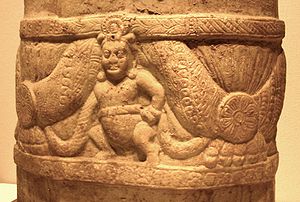
Sanchi
Sanchi is a small village in Raisen District of the state of Madhya Pradesh, India, it is located 46 km north east of Bhopal, and 10 km from Besnagar and Vidisha in the central part of the state of Madhya Pradesh. It is the location of several Buddhist monuments dating from the 3rd...
and on the other hand, the classical influence derived from Gandhara".
The influence of Greek art can be felt beyond Mathura, as far as Amaravati on the East coast of India, as shown by the usage of Greek scrolls in combination with Indian deities. Other motifs such as Greek chariots pulled by four horses can also be found in the same area.
Incidentally, Hindu art
Hindu art
-Background:Hinduism is the predominant religion in India, it has approximately 867 million followers making up about 13% of the world’s population and as such the culture that ensues it is full of different aspects of life that are effected by art...
started to develop from the 1st to the 2nd century CE and found its first inspiration in the Buddhist art of Mathura. It progressively incorporated a profusion of original Hindu stylistic and symbolic elements however, in contrast with the general balance and simplicity of Buddhist art.
The art of Mathura features frequent sexual imagery. Female images with bare breasts, nude below the waist, displaying labia and female genitalia are common. These images are more sexually explicit than those of earlier or later periods.
Art of the Gupta


Gupta Empire
The Gupta Empire was an ancient Indian empire which existed approximately from 320 to 550 CE and covered much of the Indian Subcontinent. Founded by Maharaja Sri-Gupta, the dynasty was the model of a classical civilization. The peace and prosperity created under leadership of Guptas enabled the...
, between the 4th and the 6th century CE. The art of the Gupta is considered as the pinnacle of Indian Buddhist art.
Hellenistic elements are still clearly visible in the purity of the statuary and the folds of the clothing, but are improved upon with a very delicate rendering of the draping and a sort of radiance reinforced by the usage of pink sandstone.
Artistic details tend to be less realistic, as seen in the symbolic shell-like curls used to render the hairstyle of the Buddha.
Expansion in Central Asia
Greco-Buddhist artistic influences naturally followed Buddhism in its expansion to Central and Eastern Asia from the 1st century BCE.Bactria
.jpg)
Bactria
Bactria and also appears in the Zend Avesta as Bukhdi. It is the ancient name of a historical region located between south of the Amu Darya and west of the Indus River...
was under direct Greek control for more than two centuries from the conquests of Alexander the Great in 332 BCE to the end of the Greco-Bactrian kingdom around 125 BCE. The art of Bactria was almost perfectly Hellenistic as shown by the archaeological remains of Greco-Bactrian cities such as Alexandria on the Oxus (Ai-Khanoum
Ai-Khanoum
Ai-Khanoum or Ay Khanum , was founded in the 4th century BC, following the conquests of Alexander the Great and was one of the primary cities of the Greco-Bactrian kingdom...
), or the numismatic art of the Greco-Bactrian kings, often considered as the best of the Hellenistic world, and including the largest silver and gold coins ever minted by the Greeks.
When Buddhism expanded in Central Asia from the 1st century CE, Bactria saw the results of the Greco-Buddhist syncretism arrive on its territory from India, and a new blend of sculptural representation remained until the Islamic invasions.
The most striking of these realizations are the Buddhas of Bamyan
Buddhas of Bamyan
The Buddhas of Bamiyan were two 6th century monumental statues of standing buddhas carved into the side of a cliff in the Bamyan valley in the Hazarajat region of central Afghanistan, situated northwest of Kabul at an altitude of 2,500 meters...
. They tend to vary between the 5th and the 9th century CE. Their style is strongly inspired by Hellenistic culture.
In another area of Bactria called Fondukistan, some Greco-Buddhist art survived until the 7th century in Buddhist monasteries, displaying a strong Hellenistic influence combined with Indian decorativeness and mannerism, and some influence by the Sasanid Persians.
Most of the remaining art of Bactria was destroyed from the 5th century onward: the Buddhists were often blamed for idolatry
Idolatry
Idolatry is a pejorative term for the worship of an idol, a physical object such as a cult image, as a god, or practices believed to verge on worship, such as giving undue honour and regard to created forms other than God. In all the Abrahamic religions idolatry is strongly forbidden, although...
and tended to be persecuted by the iconoclastic Muslims. Destructions continued during the Afghanistan War, and especially by the Taliban regime in 2001. The most famous case is that of the destruction of the Buddhas of Bamyan
Buddhas of Bamyan
The Buddhas of Bamiyan were two 6th century monumental statues of standing buddhas carved into the side of a cliff in the Bamyan valley in the Hazarajat region of central Afghanistan, situated northwest of Kabul at an altitude of 2,500 meters...
. Ironically, most of the remaining art from Afghanistan still extant was removed from the country during the Colonial period. In particular, a rich collection exists at the Musee Guimet in France.
Tarim Basin
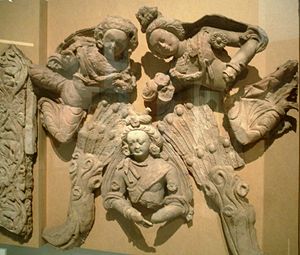

Tarim Basin
The Tarim Basin is a large endorheic basin occupying an area of about . It is located in the Xinjiang Uyghur Autonomous Region in China's far west. Its northern boundary is the Tian Shan mountain range and its southern is the Kunlun Mountains on the northern edge of the Tibetan Plateau. The...
, also called Serindian art
Serindian art
Serindian art is the art that developed from the 2nd through the 11th century C.E. in Serindia or Xinjiang, the western region of China that forms part of Central Asia....
, is the art that developed from the 2nd through the 11th century CE in Serindia
Serindia
The term Serindia combines Seres and India to refer to the part of Asia also known as Sinkiang, Chinese Turkestan or High Asia. See main entry under Xinjiang.The art of this region is known as Serindian.-References:...
or Xinjiang
Xinjiang
Xinjiang is an autonomous region of the People's Republic of China. It is the largest Chinese administrative division and spans over 1.6 million km2...
, the western region of China that forms part of Central Asia
Central Asia
Central Asia is a core region of the Asian continent from the Caspian Sea in the west, China in the east, Afghanistan in the south, and Russia in the north...
. It derives from the art of the Gandhara
Gandhara
Gandhāra , is the name of an ancient kingdom , located in northern Pakistan and eastern Afghanistan. Gandhara was located mainly in the vale of Peshawar, the Potohar plateau and on the Kabul River...
and clearly combines Indian traditions with Greek and Roman influences.
Buddhist missionaries travelling on the Silk Road
Silk Road
The Silk Road or Silk Route refers to a historical network of interlinking trade routes across the Afro-Eurasian landmass that connected East, South, and Western Asia with the Mediterranean and European world, as well as parts of North and East Africa...
introduced this art, along with Buddhism
Buddhism
Buddhism is a religion and philosophy encompassing a variety of traditions, beliefs and practices, largely based on teachings attributed to Siddhartha Gautama, commonly known as the Buddha . The Buddha lived and taught in the northeastern Indian subcontinent some time between the 6th and 4th...
itself, into Serindia, where it mixed with Chinese and Persian influences.
Influences in Eastern Asia
The arts of China, Korea and Japan adopted Greco-Buddhist artistic influences, but tended to add many local elements as well. What remains most readily identifiable from Greco-Buddhist art are:- The general idealistic realism of the figures reminiscent of Greek art.
- Clothing elements with elaborate Greek-style folds.
- The curly hairstyle characteristic of the Mediterranean.
- In some Buddhist representations, hovering winged figures holding a wreath.
- Greek sculptural elements such as vines and floral scrolls.
China
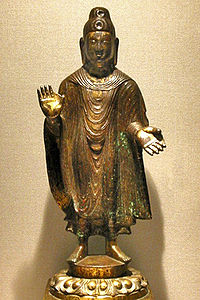
Some Northern Wei statues can be quite reminiscent of Gandharan standing Buddha, although in a slightly more symbolic style. The general attitude and rendering of the dress however remain. Other, like Northern Qi Dynasty statues also maintain the general Greco-Buddhist style, but with less realism and stronger symbolic elements.
Some Eastern Wei statues display Buddhas with elaborate Greek-style robe foldings, and surmounted by flying figures holding a wreath.
Japan


Asuka period
The , was a period in the history of Japan lasting from 538 to 710 , although its beginning could be said to overlap with the preceding Kofun period...
, the first period following the conversion of the country to Buddhism, display a strikingly classical style, with ample Hellenistic dress and realistically rendered body shape characteristic of Greco-Buddhist art.
Other works of art incorporated a variety of Chinese and Korean influences, so that Japanese Buddhist became extremely varied in its expression. Many elements of Greco-Buddhist art remain to this day however, such as the Hercules
Hercules
Hercules is the Roman name for Greek demigod Heracles, son of Zeus , and the mortal Alcmene...
inspiration behind the Nio
Nio
Kongōrikishi or Niō are two wrath-filled and muscular guardians of the Buddha, standing today at the entrance of many Buddhist temples in China, Japan and Korea in the form of frightening wrestler-like statues. They are manifestations of the Bodhisattva ' protector deity and are part of the...
guardian deities in front of Japanese Buddhist temples, or representations of the Buddha reminiscent of Greek art such as the Buddha in Kamakura
Kamakura, Kanagawa
is a city located in Kanagawa Prefecture, Japan, about south-south-west of Tokyo. It used to be also called .Although Kamakura proper is today rather small, it is often described in history books as a former de facto capital of Japan as the seat of the Shogunate and of the Regency during the...
.

Fujin
is the Japanese god of the wind and one of the eldest Shinto gods.He is portrayed as a terrifying dark demon, resembling a red headed black humanoid wearing a leopard skin, carrying a large bag of winds on his shoulders....
. In consistency with Greek iconography for the wind god Boreas, the Japanese wind god holds above his head with his two hands a draping or "wind bag" in the same general attitude. The abundance of hair have been kept in the Japanese rendering, as well as exaggerated facial features.

Silk Road
The Silk Road or Silk Route refers to a historical network of interlinking trade routes across the Afro-Eurasian landmass that connected East, South, and Western Asia with the Mediterranean and European world, as well as parts of North and East Africa...
. Herakles was used in Greco-Buddhist art to represent Vajrapani
Vajrapani
' is one of the earliest bodhisattvas of Mahayana Buddhism. He is the protector and guide of the Buddha, and rose to symbolize the Buddha's power. Vajrapani was used extensively in Buddhist iconography as one of the three protective deities surrounding the Buddha...
, the protector of the Buddha, and his representation was then used in China and Japan to depict the protector gods of Buddhist temples.


Nara, Nara
is the capital city of Nara Prefecture in the Kansai region of Japan. The city occupies the northern part of Nara Prefecture, directly bordering Kyoto Prefecture...
temple building tiles, some of them exactly depicting vines and grapes. These motifs have evolved towards more symbolic representations, but essentially remain to this day in many Japanese traditional buildings.
Influences on South-East Asian art

Hinduism
Hinduism is the predominant and indigenous religious tradition of the Indian Subcontinent. Hinduism is known to its followers as , amongst many other expressions...
and Mahayana
Mahayana
Mahāyāna is one of the two main existing branches of Buddhism and a term for classification of Buddhist philosophies and practice...
and Theravada
Theravada
Theravada ; literally, "the Teaching of the Elders" or "the Ancient Teaching", is the oldest surviving Buddhist school. It was founded in India...
Buddhism
Buddhism
Buddhism is a religion and philosophy encompassing a variety of traditions, beliefs and practices, largely based on teachings attributed to Siddhartha Gautama, commonly known as the Buddha . The Buddha lived and taught in the northeastern Indian subcontinent some time between the 6th and 4th...
.
The influence of Greco-Buddhist art is still visible in most of the representation of the Buddha in South-East Asia, through their idealism, realism and details of dress, although they tend to intermix with Indian Hindu art, and they progressively acquire more local elements.
Cultural significance
Beyond stylistic elements which spread throughout Asia for close to a millennium, the main contribution of Greco-Buddhist art to the Buddhist faith may be in the Greek-inspired idealistic realism which helped describe in a visual and immediately understandable manner the state of personal bliss and enlightenment proposed by Buddhism. The communication of deeply human approach of the Buddhist faith, and its accessibility to all have probably benefited from the Greco-Buddhist artistic syncretism.Major collections
- Peshawar MuseumPeshawar MuseumThe Peshawar Museum is a Museum situated in the historic city of Peshawar, Khyber Pakhtunkhwa, Pakistan.-Introduction:Situated between the old Deans Hotel and the Old city, about five minutes walk from Jail Bridge and the Railway station....
, PeshawarPeshawarPeshawar is the capital of Khyber-Pakhtunkhwa and the administrative center and central economic hub for the Federally Administered Tribal Areas of Pakistan....
, PakistanPakistanPakistan , officially the Islamic Republic of Pakistan is a sovereign state in South Asia. It has a coastline along the Arabian Sea and the Gulf of Oman in the south and is bordered by Afghanistan and Iran in the west, India in the east and China in the far northeast. In the north, Tajikistan...
(largest collection in the world). - Lahore MuseumLahore MuseumLahore Museum , established in 1894, is located in The Mall, Lahore, Punjab, Pakistan. Rudyard Kipling's father, John Lockwood Kipling, was one of the famous curators of the museum. Over 250,000 admissions were registered in 2005.-Attractions:...
, LahoreLahoreLahore is the capital of the Pakistani province of Punjab and the second largest city in the country. With a rich and fabulous history dating back to over a thousand years ago, Lahore is no doubt Pakistan's cultural capital. One of the most densely populated cities in the world, Lahore remains a...
, PakistanPakistanPakistan , officially the Islamic Republic of Pakistan is a sovereign state in South Asia. It has a coastline along the Arabian Sea and the Gulf of Oman in the south and is bordered by Afghanistan and Iran in the west, India in the east and China in the far northeast. In the north, Tajikistan...
. - Taxila MuseumTaxila MuseumTaxila Museum is located at Taxila, Punjab, Pakistan.-Location:Taxila Museum is located 35 km from Islamabad on the Grand Trunk Road to Peshawar. It is famous for remains of Gandhara art...
, TaxilaTaxilaTaxila is a Tehsil in the Rawalpindi District of Punjab province of Pakistan. It is an important archaeological site.Taxila is situated about northwest of Islamabad Capital Territory and Rawalpindi in Panjab; just off the Grand Trunk Road...
, PakistanPakistanPakistan , officially the Islamic Republic of Pakistan is a sovereign state in South Asia. It has a coastline along the Arabian Sea and the Gulf of Oman in the south and is bordered by Afghanistan and Iran in the west, India in the east and China in the far northeast. In the north, Tajikistan...
. - National Museum of PakistanNational Museum of PakistanThe National Museum of Pakistan is located in Karachi, Sindh, Pakistan. National Museum of Pakistan was established in Frere Hall on April 17, 1950, replacing the defunct Victoria Museum. Frere Hall itself was built in 1865 as a tribute to Sir Bartle Frere, a Commissioner of Sind during the...
, KarachiKarachiKarachi is the largest city, main seaport and the main financial centre of Pakistan, as well as the capital of the province of Sindh. The city has an estimated population of 13 to 15 million, while the total metropolitan area has a population of over 18 million...
, PakistanPakistanPakistan , officially the Islamic Republic of Pakistan is a sovereign state in South Asia. It has a coastline along the Arabian Sea and the Gulf of Oman in the south and is bordered by Afghanistan and Iran in the west, India in the east and China in the far northeast. In the north, Tajikistan...
. - Indian MuseumIndian MuseumThe Indian Museum is the largest museum in India and has rare collections of antiques, armour and ornaments, fossils, skeletons, mummies, and Mughal paintings...
, Kolkata, West Bengal, IndiaIndiaIndia , officially the Republic of India , is a country in South Asia. It is the seventh-largest country by geographical area, the second-most populous country with over 1.2 billion people, and the most populous democracy in the world...
. - Mathura MuseumMathura MuseumMathura museum is an archaeological museum in Mathura city of Uttar Pradesh state in India. The museum was founded by then collector of the Mathura district, Sir F.S Growse in 1874...
, Mathura, IndiaIndiaIndia , officially the Republic of India , is a country in South Asia. It is the seventh-largest country by geographical area, the second-most populous country with over 1.2 billion people, and the most populous democracy in the world...
. - Musée Guimet, ParisParisParis is the capital and largest city in France, situated on the river Seine, in northern France, at the heart of the Île-de-France region...
, FranceFranceThe French Republic , The French Republic , The French Republic , (commonly known as France , is a unitary semi-presidential republic in Western Europe with several overseas territories and islands located on other continents and in the Indian, Pacific, and Atlantic oceans. Metropolitan France...
(about 150 artifacts, largest collection outside of Asia.) - British MuseumBritish MuseumThe British Museum is a museum of human history and culture in London. Its collections, which number more than seven million objects, are amongst the largest and most comprehensive in the world and originate from all continents, illustrating and documenting the story of human culture from its...
, LondonLondonLondon is the capital city of :England and the :United Kingdom, the largest metropolitan area in the United Kingdom, and the largest urban zone in the European Union by most measures. Located on the River Thames, London has been a major settlement for two millennia, its history going back to its...
, Great BritainGreat BritainGreat Britain or Britain is an island situated to the northwest of Continental Europe. It is the ninth largest island in the world, and the largest European island, as well as the largest of the British Isles...
(about 100 artifacts), such as Seated Buddha from GandharaSeated Buddha from GandharaThe Seated Buddha from Gandhara is an early statue of the Buddha made in Gandhara, in modern Pakistan, in the 2nd or 3rd century. It is now in room 33 of the British Museum. Statues of the "enlightened one" were not made until the 1st century AD, before that Buddha was represented by aniconic... - Tokyo National MuseumTokyo National MuseumEstablished 1872, the , or TNM, is the oldest and largest museum in Japan. The museum collects, houses, and preserves a comprehensive collection of art works and archaeological objects of Asia, focusing on Japan. The museum holds over 110,000 objects, which includes 87 Japanese National Treasure...
, TokyoTokyo, ; officially , is one of the 47 prefectures of Japan. Tokyo is the capital of Japan, the center of the Greater Tokyo Area, and the largest metropolitan area of Japan. It is the seat of the Japanese government and the Imperial Palace, and the home of the Japanese Imperial Family...
, JapanJapanJapan is an island nation in East Asia. Located in the Pacific Ocean, it lies to the east of the Sea of Japan, China, North Korea, South Korea and Russia, stretching from the Sea of Okhotsk in the north to the East China Sea and Taiwan in the south...
(about 50 artifacts) - National Museum of Oriental ArtNational Museum of Oriental ArtThe National Museum of Oriental Art is an important museum in Rome, Italy, dedicated to the arts of the Orient, from the Middle East to Japan....
, RomeRomeRome is the capital of Italy and the country's largest and most populated city and comune, with over 2.7 million residents in . The city is located in the central-western portion of the Italian Peninsula, on the Tiber River within the Lazio region of Italy.Rome's history spans two and a half...
, ItalyItalyItaly , officially the Italian Republic languages]] under the European Charter for Regional or Minority Languages. In each of these, Italy's official name is as follows:;;;;;;;;), is a unitary parliamentary republic in South-Central Europe. To the north it borders France, Switzerland, Austria and...
(about 80 artifacts) - Museum of Indian Art, Dahlem, BerlinBerlinBerlin is the capital city of Germany and is one of the 16 states of Germany. With a population of 3.45 million people, Berlin is Germany's largest city. It is the second most populous city proper and the seventh most populous urban area in the European Union...
, GermanyGermanyGermany , officially the Federal Republic of Germany , is a federal parliamentary republic in Europe. The country consists of 16 states while the capital and largest city is Berlin. Germany covers an area of 357,021 km2 and has a largely temperate seasonal climate...
.
Small collections
- Metropolitan Museum of ArtMetropolitan Museum of ArtThe Metropolitan Museum of Art is a renowned art museum in New York City. Its permanent collection contains more than two million works, divided into nineteen curatorial departments. The main building, located on the eastern edge of Central Park along Manhattan's Museum Mile, is one of the...
, New YorkNew YorkNew York is a state in the Northeastern region of the United States. It is the nation's third most populous state. New York is bordered by New Jersey and Pennsylvania to the south, and by Connecticut, Massachusetts and Vermont to the east...
, USA - Ancient Orient MuseumAncient Orient MuseumThe is a small private museum in Tokyo, Japan, specializing in artifacts of the ancient Near East and Central Asia. It has a collection of Greco-Buddhist art of Gandhara, and several pieces pertaining to the art of Palmyra and Persia....
, Tokyo, Japan (About 20 artifacts) - Victoria and Albert MuseumVictoria and Albert MuseumThe Victoria and Albert Museum , set in the Brompton district of The Royal Borough of Kensington and Chelsea, London, England, is the world's largest museum of decorative arts and design, housing a permanent collection of over 4.5 million objects...
, London, Great Britain (About 30 artifacts) - City Museum of Ancient Art in Palazzo MadamaPalazzo Madama, TurinPalazzo Madama e Casaforte degli Acaja is a palace in Turin, northern Italy.-History:At the beginning of the first century BC, the site of the palace was occupied by a gate in the Roman walls from which the decumanus maximus of Augusta Taurinorum departed. Two of the towers, although restored,...
, TurinTurinTurin is a city and major business and cultural centre in northern Italy, capital of the Piedmont region, located mainly on the left bank of the Po River and surrounded by the Alpine arch. The population of the city proper is 909,193 while the population of the urban area is estimated by Eurostat...
, ItalyItalyItaly , officially the Italian Republic languages]] under the European Charter for Regional or Minority Languages. In each of these, Italy's official name is as follows:;;;;;;;;), is a unitary parliamentary republic in South-Central Europe. To the north it borders France, Switzerland, Austria and...
. - Rubin Museum of ArtRubin Museum of Art__notoc__The Rubin Museum of Art is a museum dedicated to the collection, display, and preservation of the art of the Himalayas and surrounding regions, especially that of Tibet...
in New York City, NY, United StatesUnited StatesThe United States of America is a federal constitutional republic comprising fifty states and a federal district...
.

